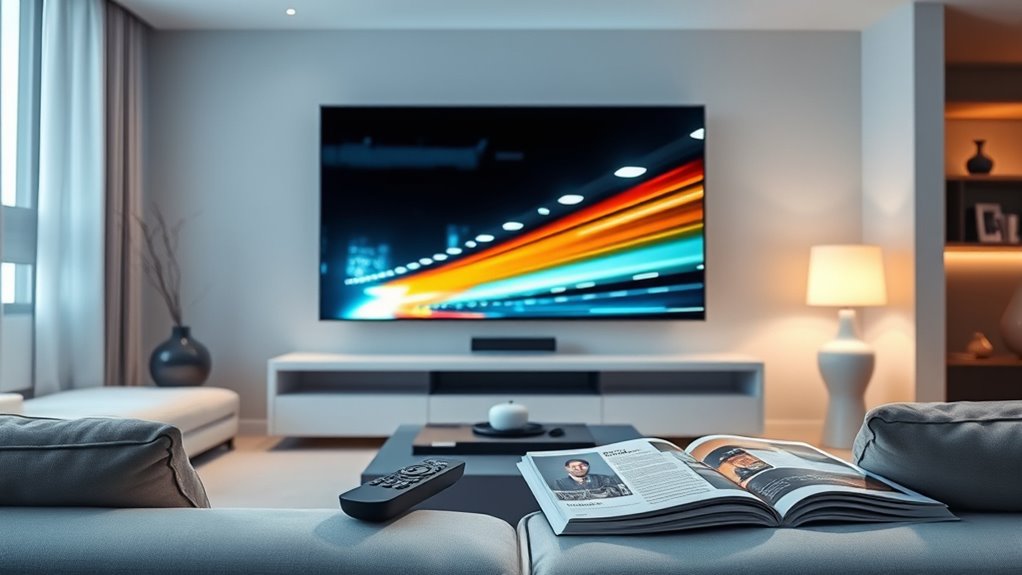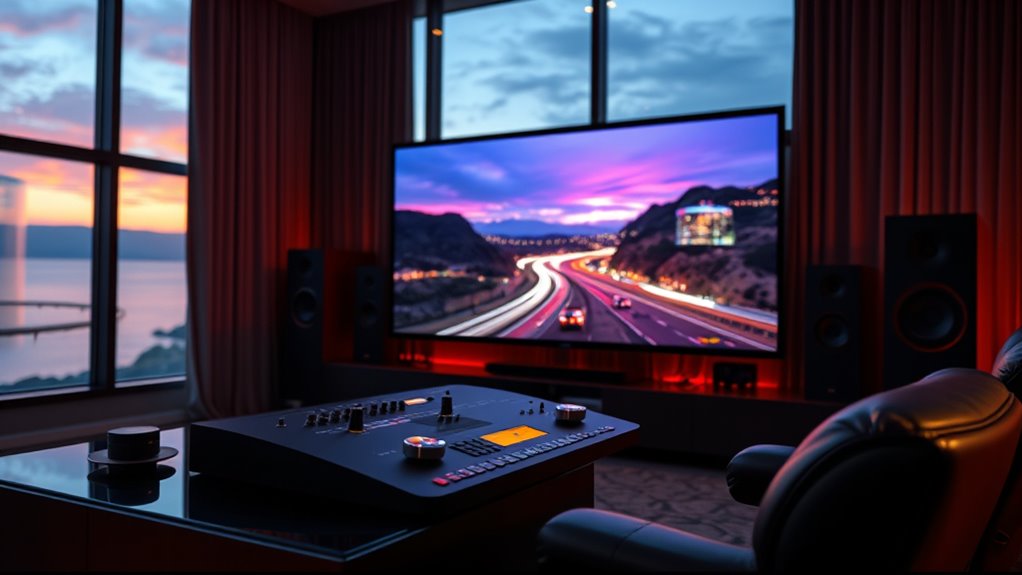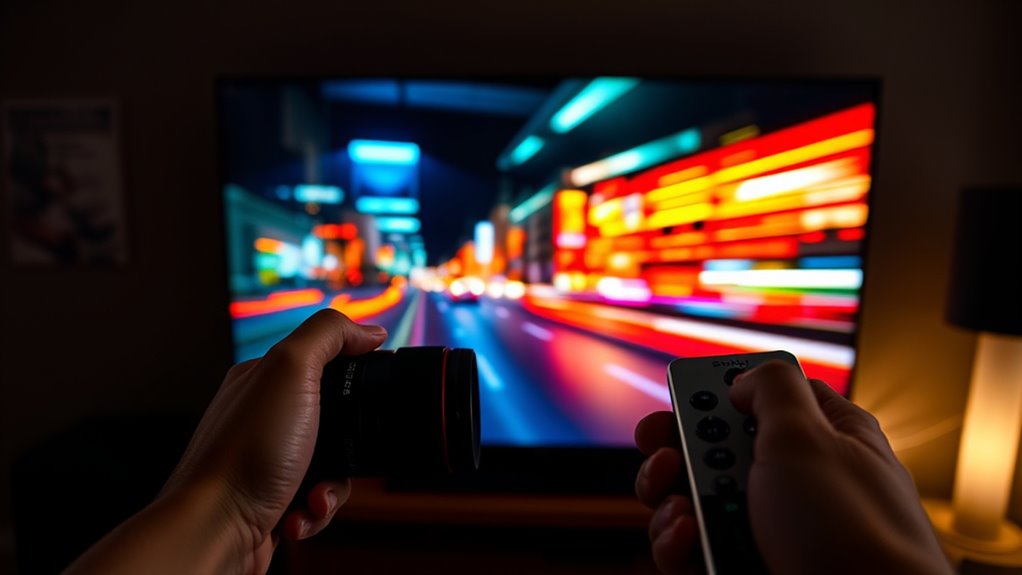Motion interpolation can make your favorite shows look smoother, but it also has hidden costs like increased input lag, unnatural motion effects, and distracting artifacts such as ghosting or soap-opera effects. These issues can cause eye strain, reduce picture quality, and interfere with fast-paced scenes. To avoid these problems, you can tweak or disable the settings and find a balance that suits your preferences. Continue exploring to discover how to optimize your viewing experience.
Key Takeaways
- Motion interpolation can cause unnatural artifacts like ghosting and soap-opera effects, reducing picture realism.
- Increased input lag from processing delays may impair gaming responsiveness and fast-paced reactions.
- Overuse leads to eye strain, visual fatigue, and distraction, diminishing overall viewing comfort.
- Higher energy consumption and potential audio-video sync issues are hidden costs of aggressive settings.
- Proper calibration and selective adjustment help minimize artifacts and balance smoothness with natural motion.
Understanding Motion Interpolation and Its Features

Motion interpolation is a technology designed to smooth out fast-moving scenes by creating additional frames between the original ones. It works through frame rate conversion, where the TV estimates new frames to enhance motion clarity. This process relies on motion smoothing algorithms that analyze existing frames to generate intermediate images, making motion appear more fluid. By increasing the frame rate, motion interpolation reduces judder and tearing during rapid movement, delivering a crisper viewing experience. However, this enhancement can sometimes make scenes look unnatural or overly hyper-realistic, known as the “soap opera effect.” Understanding how motion smoothing operates helps you recognize when it’s improving your viewing experience or when it might be distorting the original cinematic intent.
Benefits of Using Motion Interpolation

Motion interpolation can make fast-moving scenes appear smoother and more natural, reducing motion blur. You’ll notice a clearer, more seamless viewing experience, especially during action sequences. This technology can enhance your overall enjoyment by providing sharper, more consistent motion on screen. Additionally, understanding ergonomics can help you optimize your viewing setup to reduce eye strain and fatigue during extended use. Properly adjusting your display settings can further improve comfort and image quality over long viewing periods. Being aware of potential artifacts can also help you avoid unwanted visual distortions or ghosting effects that sometimes occur with motion interpolation. Furthermore, selecting appropriate refresh rates can improve motion clarity, minimizing flickering and enhancing the viewing experience. As technology advances, automation in display features aims to improve overall user experience and reduce the need for manual adjustments.
Smoother Motion Clarity
When motion interpolation is enabled, it creates a series of intermediate frames that smooth out fast-moving scenes, making quick actions appear more fluid and natural. This process effectively increases the perceived frame rate, resulting in clearer motion during fast-paced sequences. With motion smoothing, you notice less judgling or blurriness, which enhances your viewing clarity. The higher frame rate achieved through interpolation reduces motion blur, allowing you to see details more sharply in rapid movements. This benefit is especially noticeable in sports or action films, where smoothness adds to the realism. Overall, by improving motion clarity, motion interpolation helps you enjoy a more immersive and visually coherent experience, especially during scenes with quick or complex motion. Additionally, some systems incorporate crochet styles for locs or other customizable visual adjustments to optimize the viewing experience further. Incorporating advanced processing techniques can also help mitigate potential artifacts or halos caused by motion interpolation, ensuring a cleaner image quality.
Enhanced Viewing Experience
By enabling motion interpolation, you considerably enhance your overall viewing experience. Frame interpolation and motion smoothing create smoother, more fluid motion, reducing judder and blurriness during fast-paced scenes. This makes action movies, sports, and video games more immersive, providing clarity that keeps you engaged. The table below highlights key benefits of motion interpolation:
| Benefit | Description |
|---|---|
| Smoother Motion | Reduces motion blur for sharper images |
| Clearer Details | Preserves fine details in fast scenes |
| Reduced Judder | Eliminates flickering during rapid movements |
| Enhanced Realism | Creates lifelike motion, improving immersion |
| Better Experience | Overall, makes viewing more engaging and enjoyable |
Using frame interpolation and motion smoothing, you enjoy a visually superior experience that feels more natural and vibrant. Additionally, understanding motion interpolation can help you make informed decisions about when to use or disable it for optimal viewing. Recognizing how frame interpolation works can also assist in customizing your viewing settings for different content types. For example, some viewers may find that disabling motion interpolation reduces soap opera effect and provides a more authentic cinema-like experience.
Common Drawbacks and Hidden Costs

While motion interpolation can improve picture smoothness, it often comes with drawbacks you should consider. You might notice increased input lag that affects your gaming or fast-paced activities. Additionally, unnatural motion artifacts can make scenes look unrealistic or distracting. Moreover, excessive use of motion interpolation may lead to visual fatigue over extended viewing periods. Studies show that prolonged exposure to certain display technologies can contribute to eye strain and discomfort. Furthermore, the performance tuning of display settings can influence the severity of these issues, making it important to customize your viewing experience appropriately. Being aware of waterpark amenities and how they impact your stay can help you better plan and avoid unexpected costs during your vacation.
Increased Input Lag
Motion interpolation often introduces a noticeable delay between your input commands and the on-screen response, which can be frustrating for gamers and fast-paced action viewers. This increased input lag happens because the processing needed to generate new frames adds extra time, affecting your overall experience. The frame rate may drop or become inconsistent as the system prioritizes smoothing motion over responsiveness. As a result, your commands may feel less immediate, making precise control difficult. If you rely on quick reactions, this delay can hinder your gameplay or fast-paced viewing. In a nutshell, motion interpolation’s effort to create seamless motion comes at the cost of increased input delay, reducing your ability to react swiftly and accurately. Additionally, the added processing can sometimes cause audio-video sync issues, which further diminishes the viewing experience. Moreover, the reliance on advanced AI safety measures in modern systems underscores the importance of balancing performance with user responsiveness. Implementing security zone info awareness can help optimize system settings for better performance. To mitigate these issues, users often need to adjust motion settings or disable interpolation entirely for optimal responsiveness. Being aware of these hidden costs allows users to make better-informed choices when configuring their displays for different activities.
Unnatural Motion Artifacts
As motion interpolation works to make fast-moving scenes smoother, it can sometimes produce unnatural motion artifacts that distract and detract from the viewing experience. These visual artifacts often appear as ghosting, double images, or a soap-opera effect, making scenes look uncanny or artificial. Motion smoothing algorithms interpret motion differently, which can cause the image to seem less natural. You might notice a jittery or overly fluid look that feels off, especially during fast-paced action or quick camera pans. These artifacts can be particularly distracting, pulling you out of the story and reducing overall picture quality. To avoid or minimize these issues, consider turning off motion interpolation or adjusting its settings for a more natural viewing experience. Additionally, understanding how currency fluctuations impact investments can help viewers make more informed decisions about their financial activities. Recognizing visual artifacts and their causes can empower you to better troubleshoot and optimize your viewing setup, especially since motion processing can vary widely across different devices and settings.
Key Terms and Glossary of Motion Interpolation

Have you ever wondered what those terms like “frame interpolation” or “motion smoothing” really mean when you watch a TV or movie? These terms describe techniques that alter the perceived frame rate by generating extra frames between original ones. At the core are interpolation algorithms, which analyze motion data to create smooth transitions. Here’s a quick glossary:
| Term | Definition | Relevance |
|---|---|---|
| Frame Rate | Number of frames displayed per second | Higher rates can improve motion clarity |
| Interpolation Algorithms | Software methods to generate new frames | Impact motion smoothness and artifact risk |
| Motion Smoothing | Technique to reduce judder by adding frames | Can cause unnatural motion effects |
| Frame Interpolation | Creating intermediate frames for fluidity | Often used in TVs for a smoother experience |
Understanding these terms helps you navigate motion interpolation’s effects.
Practical Tips to Minimize Negative Effects

To reduce the negative effects of motion interpolation, you can modify your TV or device settings to turn off or fine-tune the feature. Start by exploring calibration techniques to optimize picture quality according to your preferences. Many TVs offer settings like “Judder Reduction,” “Motion Smoothing,” or “TruMotion,” which you can customize to strike a balance between smoothness and natural motion. Adjust these settings gradually and test with content you watch regularly to see what feels most comfortable. Remember, viewer preferences vary; some prefer minimal intervention, while others want a more fluid look. Taking the time to calibrate your device ensures you minimize artifacts like soap opera effect while enjoying the best possible viewing experience tailored to your taste.
Making an Informed Choice for Your Viewing Experience

Choosing the right motion settings depends on understanding how they affect your viewing experience. Adjusting these settings can improve your viewing comfort by reducing motion blur or judder, but they may also increase energy consumption. If you prioritize a natural look, turning off or reducing interpolation might be best, especially if you’re sensitive to artificial motion effects. On the other hand, if smooth motion enhances your experience, enabling high settings could be worth the extra energy use. Consider your habits and preferences—long viewing sessions may warrant energy-efficient choices to save power. Ultimately, making an informed decision involves balancing viewing comfort with energy consumption. Experiment with different settings to find what works best for you without compromising your overall watching satisfaction.
Frequently Asked Questions
How Can I Disable Motion Interpolation on My TV?
To disable motion interpolation on your TV, access the calibration settings or picture menu. Look for options like “Motion Smoothing,” “Auto Motion,” or “TruMotion.” Use your remote to turn these settings off, aligning with your user preferences for a more natural picture. If you’re unsure, consult your TV’s user manual or online support for specific instructions tailored to your model.
Does Motion Interpolation Affect Gaming Performance?
Think of motion interpolation like a double-edged sword slicing through your gaming experience. It can introduce extra gaming latency, causing delays that make fast-paced action feel sluggish. Plus, it may create image artifacts, distorting details and hampering your accuracy. To keep your gameplay sharp, consider disabling motion interpolation. This way, you minimize latency and avoid artifacts, ensuring your gaming performance stays responsive and visually clear.
Are There Alternative Technologies to Reduce Motion Blur?
Yes, you can reduce motion blur with alternative technologies like frame interpolation and flicker reduction. Frame interpolation creates intermediate frames to smooth out motion, decreasing blur, while flicker reduction minimizes flickering effects that can cause eye strain. These methods improve your viewing experience without the potential downsides of traditional motion interpolation. Keep in mind, though, that some users might notice artifacts or reduced sharpness, so try different settings to find what works best for you.
Can Motion Interpolation Cause Eye Strain or Discomfort?
Yes, motion interpolation can cause eye strain or discomfort. When you watch high frame rates, your eyes may struggle to adapt to the artificial motion, leading to eye fatigue and visual discomfort. If you notice these symptoms, consider turning off motion interpolation or reducing its effect. Taking regular breaks and adjusting your display settings can also help prevent eye strain and guarantee a more comfortable viewing experience.
How Do Different Brands Implement Motion Interpolation Features?
Different brands implement motion interpolation features uniquely, with variations in how they enhance or smooth motion. Some brands, like Samsung and LG, offer customizable settings for intensity and modes, while others, like Sony, focus on advanced algorithms for sharper visuals. These feature variations allow you to tailor the experience, but you should explore each brand’s implementation to find the right balance between smoothness and natural motion, avoiding potential eye strain or discomfort.
Conclusion
By understanding the hidden costs of motion interpolation, you can make smarter choices for your TV setup. Did you know that over 60% of viewers report motion artifacts or eye strain when using high-intensity interpolation? Being aware of these issues helps you enjoy smoother visuals without discomfort. With practical tips and informed decisions, you’ll optimize your viewing experience and avoid costly mistakes—so, take control and enjoy your favorite content the way you want it.














